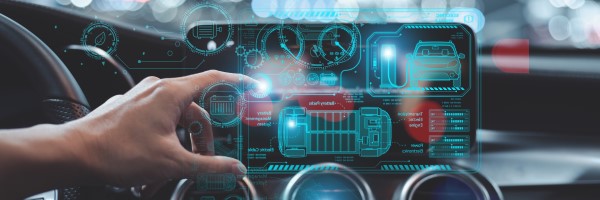Consumer Tech Enthusiasts Test Drive the Future of Automotive at CES 2024
Today’s cars are the ultimate consumer machines. The modern automobile embodies unlimited mobility, cutting-edge connectivity, and more street smarts than ever while going the distance to keep us safe and comfortable. To catch the latest auto industry trends, tech enthusiasts are converging on CES 2024, where OEMs, Tier 1 suppliers and startups are unveiling innovations that will redefine the future of automotive. From high-end infotainment to advanced safety systems and autonomous driving, many of the tech marvels showcased at CES will appear in new 2024 models as standard equipment or optional features. Here’s a sampling of what’s just down the road in automotive technology.
The software-defined car is here today
Automotive innovation is increasingly software-driven. In fact, a modern car runs on many millions of lines of code, more than used in a typical passenger aircraft. All this software enables new innovations like automotive AI assistants, virtual concierge services, in-car gaming, and other connected services that enhance our driving experiences. While some software-defined features are built into new vehicles, others are available through upfront payments and subscription models. Most consumers want essential automotive safety and infotainment features at affordable price points, while early adopters seek high-end content like gaming, video streaming, and customized audio/video. All these software-intensive automotive features share a common underlying technology: precision timing. The number of precision timing chips used in cars continues to grow as automotive features become increasingly sophisticated. Modern cars now contain up to 70 timing devices, and this number is rising with the integration of more advanced technologies and sensors to keep drivers safe and connected.

Automotive safety transitions from passive to proactive systems
Safety standards such as ISO 26262 and SOTIF are driving an active safety paradigm in automotive design, essential for achieving the objectives of Vision Zero—a strategy aimed at eradicating traffic fatalities and severe injuries. Precision timing technology assumes a critical role in upholding functional safety as the industry pivots from passive to active safety systems. Vehicles equipped with ADAS computers and sensor-rich safety systems necessitate swift, reliable communications across the car’s Ethernet backbone and wireless networks. In safety-critical automotive systems, component failure is non-negotiable. Timing devices must provide the utmost in reliability and accuracy to synchronize vast streams of sensor data, manage high-speed interfaces, and ensure seamless communications between internal and external vehicle systems, including emerging vehicle-to-everything (V2X) connectivity.

Shared mobility is on the move
The rise of shared mobility models, in which vehicles remain on the road up to 90% of the time through ridesharing or car sharing, requires highly dependable automotive systems. Frequent usage cycles and increased wear and tear call for robust automotive electronic components capable of enduring elevated duty cycles subject to high temperatures, intense vibration and mechanical shocks. With vehicles staying on the road for longer stretches, reliability in automotive electronics becomes paramount. Highly reliable and robust precision timing devices are critical in keeping automotive systems up running, enabling the continuous and safe operation of shared vehicles. Oscillators, for example, play a pivotal role in clocking functions for digital systems in cars such as electronic control units (ECUs), advanced driver assistance systems (ADAS), in-vehicle networks, and other subsystems.

Autonomous vehicle technology fuels a surge in data
As vehicles rapidly progress from levels 2 and 3 toward level 4 autonomy, consumers have come to expect varying levels of autonomous driving features. Expectations for autonomous technologies range from private autonomy to automated valet parking and robo-taxis to self-driving freight transport and last-mile delivery. As vehicles become laden with more sensors to achieve automation, they generate an excess of 20TB of data per hour. This deluge of data requires seamless communications and advanced processing capabilities, demanding up to 100 TFLOPS of compute power. Precision timing is critical in managing this tremendous data flow. Timing devices must continually synchronize high-speed data transfers from diverse sensors to ADAS computers and ECUs. For active safety systems and autonomous driving to flourish, precision timing devices used in automotive systems must offer ultra-low jitter, exceptional stability, and reliable operation even in the harshest environmental conditions.

The EV market is shifting from early adopters to mainstream
While CES historically has focused more on automotive software, autonomy, and connectivity rather than electrification, fundamental EV technologies like charging systems and batteries are garnering considerable attention. As the EV industry transitions from early adopters to a broader, more sustainable market, driver concerns around range anxiety and charging infrastructure have impacted recent EV sales. How the automotive industry addresses these concerns in 2024 and beyond is critical for continued EV adoption. Precision timing technology will play a key role in enhancing the reliability of EV systems – and ultimately EV acceptance. For example, the higher electrical currents in EVs create electromagnetic interference that can affect the reliable operation of electronic components. Robust timing devices are essential in managing the synchronization and clocking of sensitive electronic components and systems in EVs, ensuring their dependable performance in challenging environments.

Precision timing is the heartbeat of automotive electronics
Significant innovations in software-driven automotive features, active safety systems, ridesharing and car sharing models, autonomous driving, and vehicle electrification are transforming the automotive industry. Precision timing components are integral to this evolution. Smart, connected cars and critical safety systems depend on timing components that offer exceptional reliability, stability, and performance. As the adoption of ADAS, autonomous driving capabilities and vehicle electrification accelerates, the need for precision timing technology in automotive applications has become increasingly important to synchronize these data-intensive systems. By transitioning from traditional quartz technology to microelectromechanical system (MEMS)-based precision timing, automakers and their suppliers are investing in safer, more reliable automotive system designs. SiTime's MEMS-based precision timing solutions are supporting the ongoing evolution of the automotive industry, contributing to the development of safer, more efficient, and more connected vehicles.
Related Blogs
Four Megatrends in the Automotive Industry
The Growing Complexity of Automotive System Timing
It’s All About Precision Timing: 7 Top Tech Trends for 2023
The future of E/E architecture and its impact on clocks